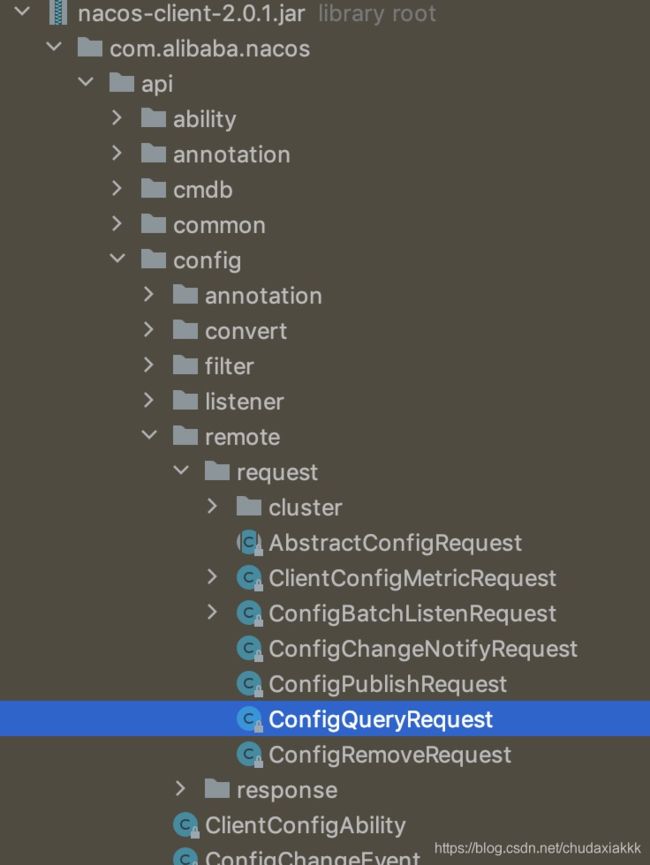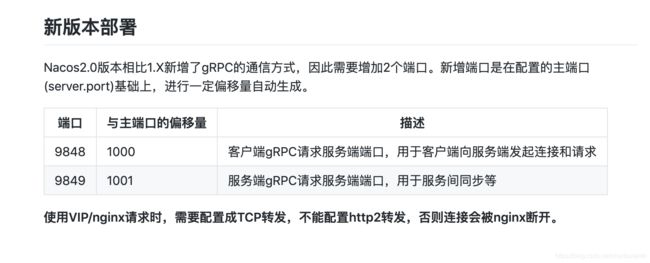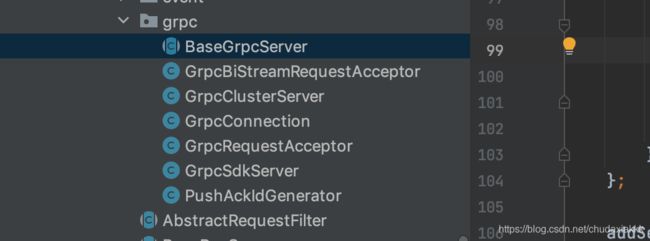nacos2.0.1 配置中心 使用grpc源码分析
经过大佬指点,选择直接看nacos2.x版本源码,探讨最新的实现方式。
1.nacos2.x的架构实现
对比1.X的架构,主要是提供了grpc的长连接实现。grpc官网传送门
grpc是一个语言无关,平台无关的rpc实现框架,谷歌开源,支持多种编程语言。使用HTTP2.0的特性,支持长连接,服务端推送,header压缩,多路复用。HTTP2.0特性介绍
从架构图可以看到,2.x框架,主要是添加了grpc通信实现,是兼容1.x版本。使用grpc,主要是为了解析1.x框架下,http连接带来的短连接,频繁心跳包导致的资源空耗,还有UDP协议,广播不可靠。
详情看阿里nacos PMC写的文章 支持 gRPC 长链接,深度解读 Nacos 2.0 架构设计及新模型
2.源码分析nacos 2.0.1客户端 配置中心使用grpc
引入sdk
com.alibaba.nacos
nacos-client
2.0.1
创建ConfigService
System.setProperty("nacos.logging.default.config.enabled", "false");
String serverAddr = NacosServerProperties.serverAddr;
String dataId = "austin-provider-server";
String group = "DEFAULT_GROUP";
configService = NacosFactory.createConfigService(serverAddr);观察创建配置服务的核心代码
public NacosConfigService(Properties properties) throws NacosException {
ValidatorUtils.checkInitParam(properties);
initNamespace(properties);
this.configFilterChainManager = new ConfigFilterChainManager(properties);
ServerListManager serverListManager = new ServerListManager(properties);
serverListManager.start();
this.worker = new ClientWorker(this.configFilterChainManager, serverListManager, properties);
// will be deleted in 2.0 later versions
agent = new ServerHttpAgent(serverListManager);
}核心代码在ClientWorker上
public void executeConfigListen() {
Map> listenCachesMap = new HashMap>(16);
Map> removeListenCachesMap = new HashMap>(16);
long now = System.currentTimeMillis();
boolean needAllSync = now - lastAllSyncTime >= ALL_SYNC_INTERNAL;
for (CacheData cache : cacheMap.get().values()) {
synchronized (cache) {
//check local listeners consistent.
主要核心代码在executeConfigListen方法上。功能主要是定时地查看配置项,监听本地配置和服务器配置是否一致,不一致,则同步配置。
for (Map.Entry> entry : listenCachesMap.entrySet()) {
String taskId = entry.getKey();
List listenCaches = entry.getValue();
ConfigBatchListenRequest configChangeListenRequest = buildConfigRequest(listenCaches);
configChangeListenRequest.setListen(true);
try {
//grpc调用
RpcClient rpcClient = ensureRpcClient(taskId);
ConfigChangeBatchListenResponse configChangeBatchListenResponse = (ConfigChangeBatchListenResponse) requestProxy(
rpcClient, configChangeListenRequest);
if (configChangeBatchListenResponse != null && configChangeBatchListenResponse.isSuccess()) {
Set changeKeys = new HashSet();
//handle changed keys,notify listener
if (!CollectionUtils.isEmpty(configChangeBatchListenResponse.getChangedConfigs())) {
hasChangedKeys = true;
for (ConfigChangeBatchListenResponse.ConfigContext changeConfig : configChangeBatchListenResponse
.getChangedConfigs()) {
String changeKey = GroupKey
.getKeyTenant(changeConfig.getDataId(), changeConfig.getGroup(),
changeConfig.getTenant());
changeKeys.add(changeKey);
boolean isInitializing = cacheMap.get().get(changeKey).isInitializing();
refreshContentAndCheck(changeKey, !isInitializing);
}
}
//handler content configs
for (CacheData cacheData : listenCaches) {
String groupKey = GroupKey
.getKeyTenant(cacheData.dataId, cacheData.group, cacheData.getTenant());
if (!changeKeys.contains(groupKey)) {
//sync:cache data md5 = server md5 && cache data md5 = all listeners md5.
synchronized (cacheData) {
if (!cacheData.getListeners().isEmpty()) {
cacheData.setSyncWithServer(true);
continue;
}
}
}
cacheData.setInitializing(false);
}
}
} catch (Exception e) {
LOGGER.error("Async listen config change error ", e);
try {
Thread.sleep(50L);
} catch (InterruptedException interruptedException) {
//ignore
}
}
}
看一下获取配置的源码
public ConfigResponse queryConfig(String dataId, String group, String tenant, long readTimeouts, boolean notify)
throws NacosException {
ConfigQueryRequest request = ConfigQueryRequest.build(dataId, group, tenant);
request.putHeader("notify", String.valueOf(notify));
ConfigQueryResponse response = (ConfigQueryResponse) requestProxy(getOneRunningClient(), request,
readTimeouts);
ConfigResponse configResponse = new ConfigResponse();
if (response.isSuccess()) {
LocalConfigInfoProcessor.saveSnapshot(this.getName(), dataId, group, tenant, response.getContent());
configResponse.setContent(response.getContent());
String configType;
if (StringUtils.isNotBlank(response.getContentType())) {
configType = response.getContentType();
} else {
configType = ConfigType.TEXT.getType();
}
configResponse.setConfigType(configType);
String encryptedDataKey = response.getEncryptedDataKey();
LocalEncryptedDataKeyProcessor
.saveEncryptDataKeySnapshot(agent.getName(), dataId, group, tenant, encryptedDataKey);
configResponse.setEncryptedDataKey(encryptedDataKey);
return configResponse;
} else if (response.getErrorCode() == ConfigQueryResponse.CONFIG_NOT_FOUND) {
LocalConfigInfoProcessor.saveSnapshot(this.getName(), dataId, group, tenant, null);
LocalEncryptedDataKeyProcessor.saveEncryptDataKeySnapshot(agent.getName(), dataId, group, tenant, null);
return configResponse;
} else if (response.getErrorCode() == ConfigQueryResponse.CONFIG_QUERY_CONFLICT) {
LOGGER.error(
"[{}] [sub-server-error] get server config being modified concurrently, dataId={}, group={}, "
+ "tenant={}", this.getName(), dataId, group, tenant);
throw new NacosException(NacosException.CONFLICT,
"data being modified, dataId=" + dataId + ",group=" + group + ",tenant=" + tenant);
} else {
LOGGER.error("[{}] [sub-server-error] dataId={}, group={}, tenant={}, code={}", this.getName(), dataId,
group, tenant, response);
throw new NacosException(response.getErrorCode(),
"http error, code=" + response.getErrorCode() + ",dataId=" + dataId + ",group=" + group
+ ",tenant=" + tenant);
}
}nacos2.x使用策略模式,创建多种请求类型。
ConfigQueryRequest是用于查询配置,注意request名字,在server端,将会根据该类名查找相应的处理类。
3.源码分析nacos 2.0.1服务端 配置中心使用grpc
3.1grpc的proto文件
nacos使用grpc,采用大而全的方式。所有request都抽象成一个服务处理。proto文件在nacos-api包上,nacos_grpc_service.proto
/*
* Copyright 1999-2020 Alibaba Group Holding Ltd.
*
* Licensed under the Apache License, Version 2.0 (the "License");
* you may not use this file except in compliance with the License.
* You may obtain a copy of the License at
*
* http://www.apache.org/licenses/LICENSE-2.0
*
* Unless required by applicable law or agreed to in writing, software
* distributed under the License is distributed on an "AS IS" BASIS,
* WITHOUT WARRANTIES OR CONDITIONS OF ANY KIND, either express or implied.
* See the License for the specific language governing permissions and
* limitations under the License.
*/
syntax = "proto3";
import "google/protobuf/any.proto";
import "google/protobuf/timestamp.proto";
option java_multiple_files = true;
option java_package = "com.alibaba.nacos.api.grpc.auto";
message Metadata {
string type = 3;
string clientIp = 8;
map headers = 7;
}
message Payload {
Metadata metadata = 2;
google.protobuf.Any body = 3;
}
service RequestStream {
// build a streamRequest
rpc requestStream (Payload) returns (stream Payload) {
}
}
service Request {
// Sends a commonRequest
rpc request (Payload) returns (Payload) {
}
}
service BiRequestStream {
// Sends a commonRequest
rpc requestBiStream (stream Payload) returns (stream Payload) {
}
}
注意到Payload,作为入参和出参。body的类型是Any,接纳各种请求类型的参数。
分了三种请求service,待确认区分目的。
使用protocol插件,生成源码
3.2grpc服务端启动端口,监听服务
在nacos架构中,grpc有两个作用,CS模式和SS模式(服务端同步信息),所以启动了两个端口服务。nacos2.x兼容性文档
代码实现在nacos-core包下
观察BaseGrpcServer,GrpcClusterServer,GrpcSdkServer。指定了启动方法和端口号偏移号
@Override
public void startServer() throws Exception {
final MutableHandlerRegistry handlerRegistry = new MutableHandlerRegistry();
// server interceptor to set connection id.
ServerInterceptor serverInterceptor = new ServerInterceptor() {
@Override
public ServerCall.Listener interceptCall(ServerCall call, Metadata headers,
ServerCallHandler next) {
Context ctx = Context.current()
.withValue(CONTEXT_KEY_CONN_ID, call.getAttributes().get(TRANS_KEY_CONN_ID))
.withValue(CONTEXT_KEY_CONN_REMOTE_IP, call.getAttributes().get(TRANS_KEY_REMOTE_IP))
.withValue(CONTEXT_KEY_CONN_REMOTE_PORT, call.getAttributes().get(TRANS_KEY_REMOTE_PORT))
.withValue(CONTEXT_KEY_CONN_LOCAL_PORT, call.getAttributes().get(TRANS_KEY_LOCAL_PORT));
if (REQUEST_BI_STREAM_SERVICE_NAME.equals(call.getMethodDescriptor().getServiceName())) {
Channel internalChannel = getInternalChannel(call);
ctx = ctx.withValue(CONTEXT_KEY_CHANNEL, internalChannel);
}
return Contexts.interceptCall(ctx, call, headers, next);
}
};
addServices(handlerRegistry, serverInterceptor);
//这里是核心代码,创建服务
server = ServerBuilder.forPort(getServicePort()).executor(getRpcExecutor())
.maxInboundMessageSize(getInboundMessageSize()).fallbackHandlerRegistry(handlerRegistry)
.compressorRegistry(CompressorRegistry.getDefaultInstance())
.decompressorRegistry(DecompressorRegistry.getDefaultInstance())
.addTransportFilter(new ServerTransportFilter() {
@Override
public Attributes transportReady(Attributes transportAttrs) {
InetSocketAddress remoteAddress = (InetSocketAddress) transportAttrs
.get(Grpc.TRANSPORT_ATTR_REMOTE_ADDR);
InetSocketAddress localAddress = (InetSocketAddress) transportAttrs
.get(Grpc.TRANSPORT_ATTR_LOCAL_ADDR);
int remotePort = remoteAddress.getPort();
int localPort = localAddress.getPort();
String remoteIp = remoteAddress.getAddress().getHostAddress();
Attributes attrWrapper = transportAttrs.toBuilder()
.set(TRANS_KEY_CONN_ID, System.currentTimeMillis() + "_" + remoteIp + "_" + remotePort)
.set(TRANS_KEY_REMOTE_IP, remoteIp).set(TRANS_KEY_REMOTE_PORT, remotePort)
.set(TRANS_KEY_LOCAL_PORT, localPort).build();
String connectionId = attrWrapper.get(TRANS_KEY_CONN_ID);
Loggers.REMOTE_DIGEST.info("Connection transportReady,connectionId = {} ", connectionId);
return attrWrapper;
}
@Override
public void transportTerminated(Attributes transportAttrs) {
String connectionId = null;
try {
connectionId = transportAttrs.get(TRANS_KEY_CONN_ID);
} catch (Exception e) {
// Ignore
}
if (StringUtils.isNotBlank(connectionId)) {
Loggers.REMOTE_DIGEST
.info("Connection transportTerminated,connectionId = {} ", connectionId);
connectionManager.unregister(connectionId);
}
}
}).build();
server.start();
} 3.3 request调度源码分析
grpc是RPC调用(remote Procedure call),protocal文件定义的是接口service。那么定义好CS接口后,服务端就要implement 接口。
grpc对于service,会创建一个抽象类,实现这个抽象类的接口。
实现了两个service, RequestGrpc和BiRequestStreamGrpc
实现类是GrpcRequestAcceptor
再看下requestHandlerRegistry,是保存registry的对象,看看它是怎么收集handler的
原理是通过spring的类查找,找到RequestHandler的所有实现类,将类名关联上处理器。
观察配置中心的实现类
好,分析先到这里。
后面将会写更多文章
- 配置管理服务间的grpc调用;
- 服务发现的grpc调用









